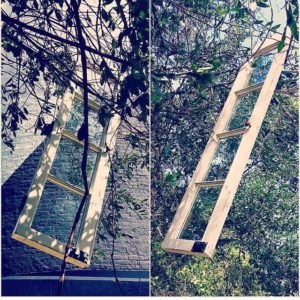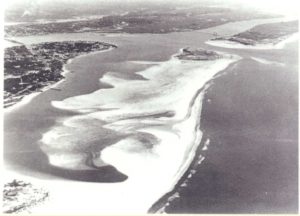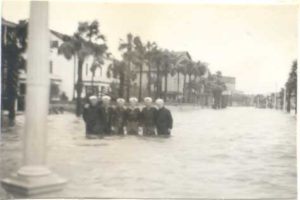It’s been about a month now since Hurricane Matthew took a swipe at St. Augustine and the rest of Florida’s East Coast before basically tracking along the shoreline up to North Carolina and finally heading out to sea. Low-lying residential areas, especially along the beaches and inland waterways, were hit hard with floodwaters and many downed trees and power lines. Downtown St. Augustine suffered flooding as well.
The Hurricane and the Lighthouse
The St. Augustine Lighthouse & Maritime  Museum, despite our location on Anastasia Island, weathered the storm well. When the U.S. Lighthouse Board picked the location for this Lighthouse to replace the old lighthouse that was threatened by beach erosion, they chose well. No floodwaters reached the Lighthouse or Keepers’ House. The only physical damage, besides several downed trees, were a few shingles missing from the roof of the Keepers’ House and a set of windows blown out of the Lighthouse and later found in a nearby tree.
Museum, despite our location on Anastasia Island, weathered the storm well. When the U.S. Lighthouse Board picked the location for this Lighthouse to replace the old lighthouse that was threatened by beach erosion, they chose well. No floodwaters reached the Lighthouse or Keepers’ House. The only physical damage, besides several downed trees, were a few shingles missing from the roof of the Keepers’ House and a set of windows blown out of the Lighthouse and later found in a nearby tree.
And now, like much of our great city, we are open for business. Hurricane Matthew came through on a Friday and by Monday morning our staff and volunteers were here cleaning up and taking down plywood to open the site by Monday afternoon. Almost all of the businesses that had to close during the storm are back open and ready to serve our wonderful residents and all the visitors we welcome to the city each year.
Hurricanes, Historically

Conch Island connected by sand dunes to the rest of Anastasia Island (Photo courtesy of St. Augustine Historical Society).
Though we do enjoy a relative lack of hurricanes historically, compared to other locations in this region of the country, St. Augustine has had its experience with strong storms. The last major hurricane to hit Northeast Florida was Hurricane Dora on September 10, 1964. The Category 3 storm’s eye came on shore in St. Augustine just after midnight and battered the area with sustained winds of 100 mph and 12 foot tides. Slow-moving Dora even contributed to the connection of two islands, depositing enough sand to merge Conch Island and Anastasia Island creating what is now Anastasia State Park.

Several “Coasties” standing in downtown St. Augustine during the Cuba-Florida Hurricane of 1944 (Photo courtesy of St. Augustine Historical Society).
In 1944, before hurricanes were given names, a strong storm came roaring across the state from the Gulf of Mexico. This storm, which was a Category 4 hurricane at its peak, is now referred to as the Cuba-Florida Hurricane, for the two places it affected the most. With the country fully engaged in WWII, St. Augustine hosted a Coast Guard Training Facility at the former Ponce de Leon Hotel (now Flagler College). Despite the fact that the hurricane did not come ashore from the Atlantic Ocean and its winds had weakened to tropical storm force as it roared over town, pictures from the time show a flooded downtown St. Augustine. In dollars adjusted for the time, it is considered the 7th costliest Atlantic hurricane since 1900.
Before Matthew, the strongest storm to directly affect Northeast Florida was the 1898 Georgia Hurricane. This storm came ashore October 2nd at Cumberland Island, GA, about 90 miles north of St. Augustine. Despite its proximity to the town, St. Augustine did not receive strong hurricane-force winds. At the St. Augustine Lighthouse, head keeper Joseph Rantia recorded the weather for those few days in his usual, short entry style:
October 1: Stormy, Rainy, Stiff Breeze From N.E.
October 2: Stormy, Rainy, Stiff Breeze From N.W.
October 3: Clear and Bright, Stiff Breeze From S.E.
And just like that, clear and bright skies replaced the rain and wind of the 1898 Georgia Hurricane.
The most famous (or infamous) hurricane to ever hit St. Augustine may not have been a hurricane as we now classify them. In 1565, as the Spanish and French founded dueling settlements in the area, a strong storm blew through, scattering Jean Ribault’s fleet and spelling the doom of the French settlement. Without these reinforcements, the French settlement of Fort Caroline fell to the Spanish and the survivors of the wrecked ships were massacred near what is now Matanzas Inlet, named after the Spanish word meaning slaughter.
St. Augustine and its citizens have survived many storms in the city’s history. Each one has brought rain, wind, and destruction with it. And each one has left a strong, determined group of people in its wake. After Hurricane Matthew, the people of St. Augustine have come together to help one another and to return to life as usual in this charming, quirky, historic city.
We’re open! While some residents still grapple with the effects of the storm, the city is ready for visitors. Get your tickets in advance and enjoy the view from the top.
Paul Zielinski is Director of Interpretation for the St. Augustine Lighthouse & Maritime Museum. He received his master’s degree in Public History from the University of West Florida and joined the lighthouse family in 2011.

